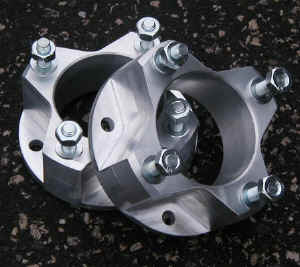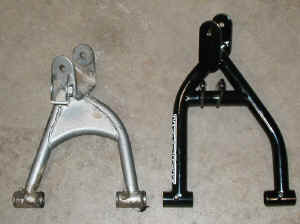Most of the Asian manufacturers have done a
commendable job balancing reliability with performance and have
ended up providing us with fairly meek, mild mannered mini quads.
But as our kids grow, inevitably the first thing they ask for is
more speed, and Kids Korner followed the tried and true process of
bolting on the essential motor goodies. With those parts we
successfully affected a significant improvement in the engine power
of our project mini-quad, but unfortunately built a machine with
almost too much motor for the chassis.
Certainly for racing intentions some suspension and chassis
enhancements are in line, but most of the mods we'll be looking at
apply to both youth riders that have developed in skill but even
the novice rider. These modifications ought to be considered by the
latter simply because they can make the machine safer- more stable
in corners, more controllable in the rough, and more predictable
over jumps.
The goal of our first phase is
to simply widen the machine. Common intuition will tell you
that wider is better for purposes of lateral stability- it's simply
harder to tip the machine over. The negatives are very few and
almost not worth mentioning: slightly more weight, theoretically a
bit less straight line stability, and higher stress on certain
components. The reality is that most youth quads could stand to be
a bit wider right from the factory.
To
actually make the ATV wider is quite simple, and there's a few
approaches to accomplishing this, varying in complexity, expense,
and ultimate machine performance.
Wheel Spacers
The most common method is to install wheel
spacers that fit between the wheel hub and wheel. These are
typically CNC machined billet aluminum and either include longer
bolts to sandwich the spacer between the wheel and hub, or separate
studs to mount the wheels.
 |
|
DMI Racing billet aluminum wheel
spacers. |
DMI Racing
manufactures these spacers for a number of common full-size
quads as well as minis. They are beautifully machined 6061 aluminum
spacers with large reliefs in the four corners to minimize the
weight. They stock them in a 2" width for the minis, but can make
them whatever size you may need. A set of two will run about
$106.95, or 4 for $199- significantly less expensive than the other
options considered in this article.
Installation is a breeze- not coincidentally about as easy as
changing your tires. However, the shock preload needs to be
increased (and hopefully there's adjustment left!) since you've
effectively increased the length of the control arm (the same
vehicle weight is acting on a longer lever arm).
The downsides to this approach are the
following:
-
additional unsprung weight at each corner-
each spacer weighs just under 2 lbs. This makes the shocks work
harder, and the suspension less capable of keeping the tire in
contact with the ground through rough terrain.
-
increased stress on the stock kingpin
(spindle); this might be an issue for heavier rider and/or
aggressive riders.
-
increased 'scrub radius', which is the
theoretical radius drawn from the front wheel spindle centerline
(where the wheel pivots) and the contact patch of the tire. This is
significant from the standpoint that forces acting on a front tire
such as bumps and braking tend to push it backward/outward. This is
felt directly by the rider through the handlebars and can be
difficult to manage for younger riders. Some call the machine
twitchy or nervous with this condition.
The upsides to wheel spacers:
-
inexpensive option compared to wider axles and
longer a-arms
-
easy installation
-
easy to modify configuration from wider to
narrower, or back to stock
A-arms
The "downtown" method of widening the machine is by
replacing your stock hardware with specialized, racing-intent
componentry. Installation of new A-arms falls into this
category. A number of companies sell mini-quad A-arms, but given
the numerous designs of quads out there, be sure to check that the
A-arms you're purchasing are a direct fit into your machine and
require no welding or shock relocation.
 |
|
A comparison of stock and Hetrick
Racing A-arms for Kasea quads |
The A-arms purchased for our phase I upgrade came
from Hetrick Racing and are specifically designed
for Kasea and LRX quads which have the 'double-clevis' style
spindle. These arms come in two varieties: "+2" and "+3", which
corresponds to the extra width (inches) per side. The Hetrick
A-arms are very nice pieces, and come in a gloss black powder coat
finish. For additional wheelbase, some other suppliers have A-arms
that additionally bring the spindle more forward, thus increasing
the wheelbase by an inch or so.
Installation of A-arms is not difficult at all for the weekend
mechanic. Unbolt the old stuff, replace or reuse the bushings,
install the A-arms, install new tire rods (longer to accommodate
the extra track width), and adjust the toe (front wheel alignment).
About a 1 hour job.
The advantages of
installing wider A-arms
-
typically, a stronger design (and less stress
on the spindle)
-
possibly additional wheelbase (+1" usually),
which can make the machine less twitchy and have better straight
line stability
-
no change in scrub radius means less
twitchiness
-
light weight
-
the ability to go a full 3" per
side
The disadvantages are:
-
about 3x pricier than spacers
-
may require new shocks (stay tuned for stage
2!) if the shock perch location is different than stock
-
more time intensive to install
Wider Axles
Most youth racers that are getting big air and
hitting whoops hard run wider axles rather than spacers for the
simple reason that the stock axle just wasn't made to take the
abuse that a fully modified mini-quad can dish out. It's not
uncommon at all to see a snapped axle on a mini-quad due to
excessive stress caused by the sudden impact of slightly cock-eyed
landing. Obviously this may cause a lost race, but more importantly
can cause serious injury to the rider.
Unfortunately, not many of the axle manufacturers have caught
on to the mini quad racing scene yet. One of the biggies has-
Durablue. At this time they only offer an axle
for the Kasea, a +4 (total) Eliminator. At $406 it's not cheap but
it's warranteed for life (for the original purchaser). With
incredible strength, and a polished and chromed outside, they are
considered the world's #1 axle.
>>>> Next Month- we venture into high performance shocks.


 Your Privacy Choices
Your Privacy Choices